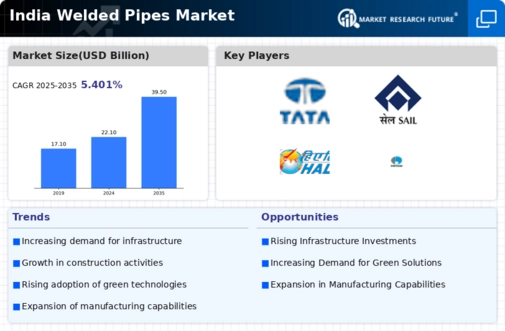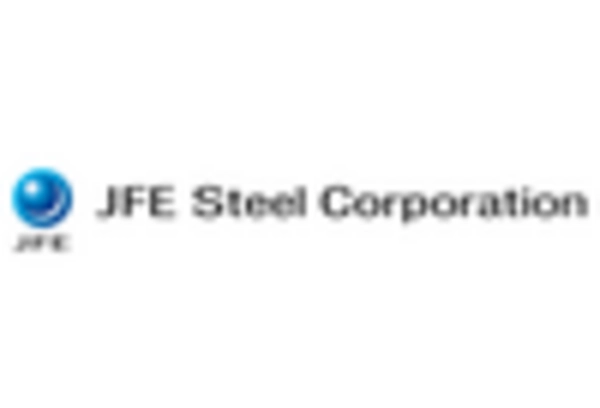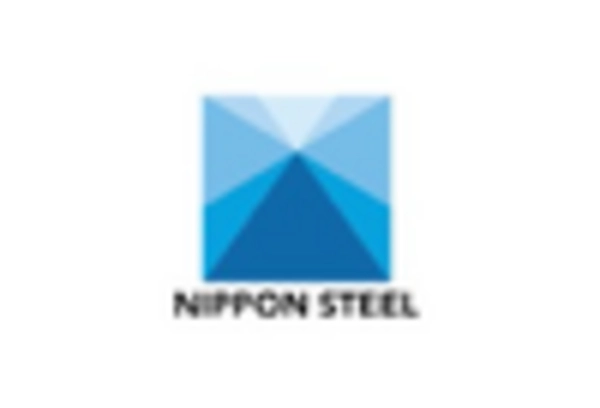Growing Energy Sector
The expansion of the energy sector in India is poised to be a major driver for the The expansion of the energy sector in India is poised to be a major driver for the market.. With the government's commitment to increasing renewable energy capacity, particularly in solar and wind energy, the need for efficient piping systems is becoming more pronounced. The energy sector's growth is projected to attract investments exceeding $20 billion by 2025, which could lead to heightened demand for welded pipes used in energy transmission and distribution. Additionally, the oil and gas industry continues to thrive, with significant investments in pipeline infrastructure. This sector's reliance on durable and high-quality welded pipes for transporting hydrocarbons suggests a sustained demand, thereby positively impacting the welded pipes market. The interplay between energy expansion and welded pipe requirements indicates a promising outlook for the industry.
Regulatory Support and Standards
Regulatory support and the establishment of standards in India are expected to bolster the Regulatory support and the establishment of standards in India are expected to bolster the market.. The Bureau of Indian Standards (BIS) has implemented various guidelines to ensure the quality and safety of welded pipes, which could enhance consumer confidence and drive market growth. Compliance with these standards is crucial for manufacturers, as it ensures that products meet the necessary safety and performance criteria. Furthermore, government policies promoting the use of high-quality materials in construction and infrastructure projects may lead to increased demand for welded pipes. As industries adapt to these regulations, the welded pipes market is likely to experience growth, driven by the need for compliance and the assurance of quality in construction materials.
Urbanization and Population Growth
Urbanization and population growth in India are likely to significantly influence the Urbanization and population growth in India are likely to significantly influence the market.. As more individuals migrate to urban areas, the demand for housing, sanitation, and infrastructure services is expected to rise. The urban population is projected to reach 600 million by 2031, necessitating extensive development in water supply and sewage systems. This surge in urbanization will likely require a substantial quantity of welded pipes for various applications, including plumbing and drainage systems. Moreover, the government's initiatives to improve urban infrastructure, such as the Atal Mission for Rejuvenation and Urban Transformation (AMRUT), further emphasize the need for welded pipes. Consequently, the welded pipes market appears to be well-positioned to benefit from these demographic trends and urban development efforts.
Infrastructure Development Initiatives
The Indian government's ongoing infrastructure development initiatives are likely to drive the The Indian government's ongoing infrastructure development initiatives are likely to drive the market.. With substantial investments in projects such as smart cities, highways, and urban transport systems, the demand for welded pipes is expected to surge. The National Infrastructure Pipeline (NIP) aims to invest over $1.4 trillion by 2025, which could significantly boost the construction and utility sectors. This increase in infrastructure projects necessitates the use of welded pipes for water supply, sewage systems, and gas distribution, thereby enhancing the market's growth prospects. Furthermore, the government's push for housing and urban development is anticipated to create a robust demand for welded pipes, as they are essential components in various construction applications. Overall, these initiatives appear to be a key driver for the welded pipes market in India.
Technological Innovations in Production
Technological innovations in the production of welded pipes are anticipated to be a significant driver for the market. Advances in manufacturing processes, such as automated welding techniques and improved quality control measures, are likely to enhance the efficiency and quality of welded pipes. These innovations can lead to reduced production costs and increased output, making welded pipes more accessible to various industries. Additionally, the integration of smart technologies in manufacturing could facilitate real-time monitoring and optimization of production processes. As manufacturers adopt these technologies, the Technological innovations in the production of welded pipes are anticipated to be a significant driver for the market. may witness a transformation, characterized by higher quality products and improved competitiveness. This technological evolution appears to be a crucial factor in shaping the future landscape of the welded pipes market.

















Leave a Comment